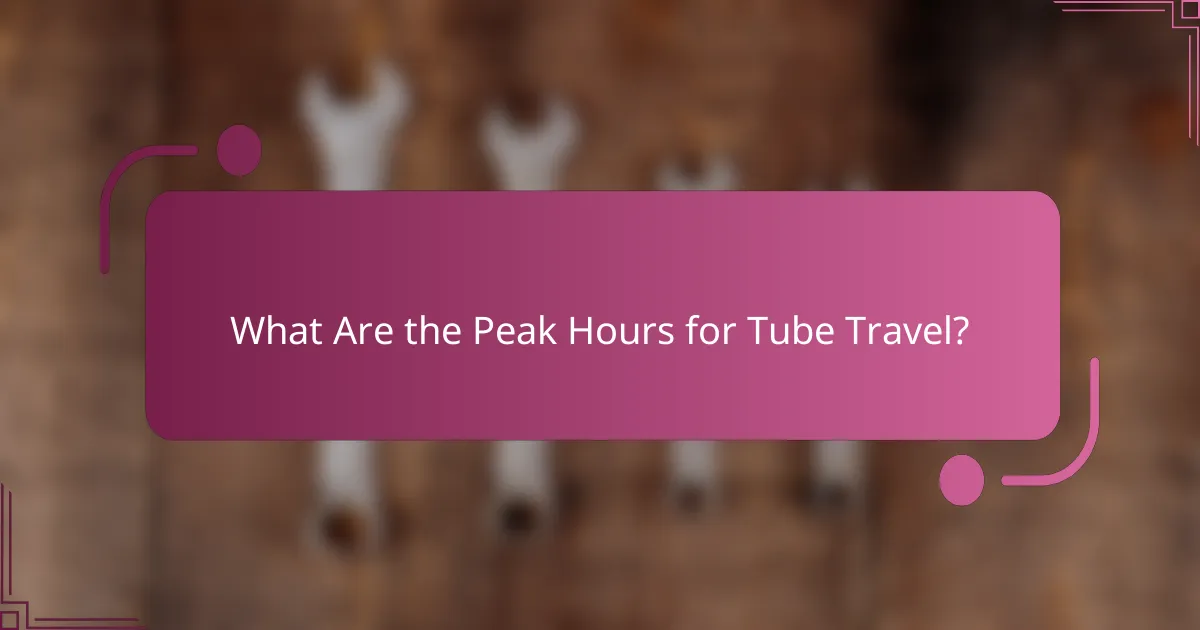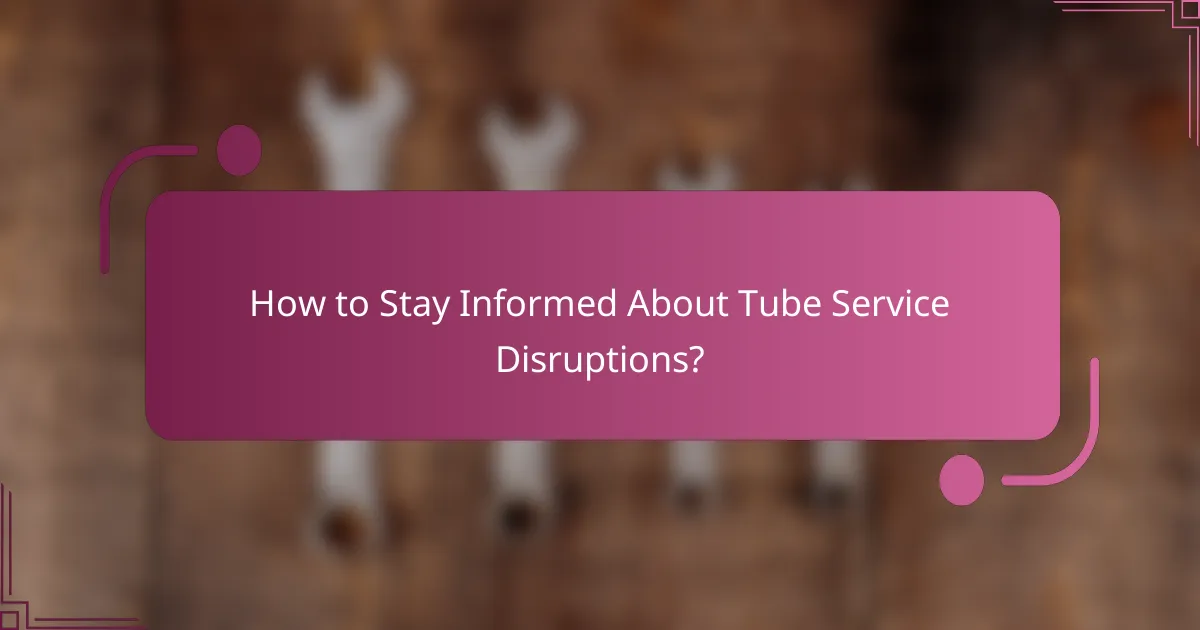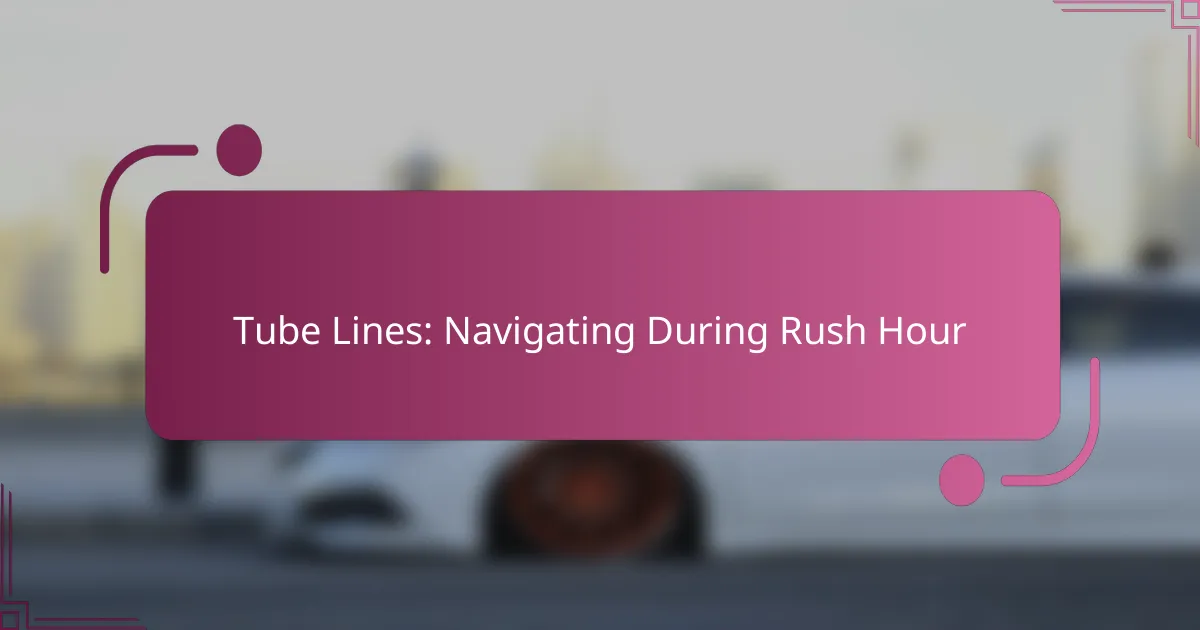Navigating Tube lines during rush hour can be a daunting task due to the high volume of passengers. To enhance your travel experience, utilize real-time apps, plan your journey in advance, and consider alternative routes. Being aware of peak travel times, typically weekday mornings and evenings, can also help you avoid the busiest trains.

How to Navigate Tube Lines During Rush Hour?
Navigating Tube lines during rush hour can be challenging due to increased passenger volume. To make your journey smoother, consider using real-time apps, planning ahead, and exploring alternative routes.
Use real-time travel apps
Real-time travel apps provide live updates on Tube services, including delays and crowd levels. Apps like Citymapper or TfL Go can help you choose the best route based on current conditions.
These apps often include features such as estimated arrival times and alerts for service disruptions, allowing you to adjust your plans on the go. Make sure to download them before your journey for seamless navigation.
Plan your journey in advance
Planning your journey ahead of time can save you from unnecessary stress during rush hour. Check the Tube map and identify your starting and ending stations to find the most efficient route.
Consider peak times and potential delays, and aim to arrive at your destination with some buffer time. Using tools like the TfL Journey Planner can help you visualize your trip and make informed decisions.
Consider alternative routes
Alternative routes can often be less crowded and faster during rush hour. Look for nearby stations that may not be as busy or explore bus routes that parallel the Tube lines.
Sometimes, a short walk to a less popular station can significantly reduce your travel time. Be flexible with your route and open to different modes of transport to enhance your journey experience.
Travel during off-peak hours
Traveling during off-peak hours can greatly improve your Tube experience. Off-peak times typically fall outside the weekday morning and evening rush hours, which are usually around 7:30 AM to 9:30 AM and 5 PM to 7 PM.
If your schedule allows, aim to travel mid-morning or early afternoon when trains are less crowded. This can lead to a more comfortable journey and shorter wait times.
Utilize express services
Express services, such as the Heathrow Express or Gatwick Express, can provide faster travel options to key destinations. These services often bypass multiple stops, reducing overall travel time.
While express services may come at a premium price, they can be worth it during peak travel times when every minute counts. Check for available express options when planning your journey to maximize efficiency.

What Are the Best Apps for Tube Navigation?
The best apps for navigating the Tube in London include Citymapper, Google Maps, the Transport for London (TfL) app, and Trainline. Each app offers unique features that can help you efficiently plan your journey during rush hour.
Citymapper
Citymapper is a highly regarded app for navigating London’s public transport, including the Tube. It provides real-time updates, route options, and estimated travel times, making it easy to find the quickest way to your destination.
One of its standout features is the ability to compare different modes of transport, such as walking, cycling, and bus routes, alongside Tube options. This flexibility is particularly useful during peak hours when Tube services may be crowded or delayed.
Google Maps
Google Maps is a versatile navigation tool that includes Tube information. It offers detailed directions, estimated travel times, and live updates on service disruptions, making it a reliable choice for commuters.
While it may not have all the specialized features of dedicated transport apps, its integration with other Google services and user-friendly interface make it a convenient option for many travelers.
Transport for London (TfL) app
The official Transport for London (TfL) app is designed specifically for navigating the Tube and other public transport in London. It provides real-time service updates, journey planning, and station information directly from the source.
This app is particularly useful for checking live departures and service status, ensuring you have the latest information before heading out. It also includes features like Oyster card management, which is essential for London commuters.
Trainline
Trainline primarily focuses on train travel but also offers Tube information for navigating London. It allows users to book tickets and check schedules for both trains and the Tube, making it a handy tool for longer journeys that involve multiple transport modes.
While it may not provide as much detail on Tube routes as other apps, its comprehensive ticketing options can save time and money, especially for intercity travel that includes Tube connections.

What Are the Peak Hours for Tube Travel?
The peak hours for Tube travel in London typically occur during weekday mornings and evenings when commuters are heading to and from work. Understanding these peak times can help you plan your journey more effectively and avoid overcrowded trains.
Weekday morning rush (7 AM – 9 AM)
The weekday morning rush on the Tube runs from approximately 7 AM to 9 AM, with the busiest times usually around 8 AM. During this period, trains can become extremely crowded, especially on popular lines such as the Central and Northern lines.
To navigate this rush, consider traveling slightly earlier or later than the peak window. If you must travel during these hours, aim to board at less busy stations or use alternative routes to minimize wait times and discomfort.
Weekday evening rush (5 PM – 7 PM)
The weekday evening rush occurs from about 5 PM to 7 PM, with the highest volume of passengers typically around 6 PM. Commuters returning home can lead to packed trains, particularly on main lines heading out of central London.
To ease your journey, try to leave work a bit earlier or later than the peak times. If possible, avoid transferring at major interchange stations during this period, as they can become bottlenecks filled with travelers.

What Are the Common Challenges During Rush Hour?
During rush hour, commuters face several challenges that can significantly affect their travel experience. The most common issues include overcrowding on trains, delayed services, and increased travel times, all of which can lead to frustration and inconvenience.
Overcrowding on trains
Overcrowding is a prevalent issue during rush hour, as many commuters rely on public transport to get to work or school. Trains often operate at or above capacity, making it difficult for passengers to board and find comfortable standing or seating space.
To mitigate overcrowding, consider traveling during off-peak hours if your schedule allows. If you must travel during peak times, aim to board at less busy stations or use alternative routes that may be less congested.
Delayed services
Delays are common during rush hour due to high demand and operational challenges. Factors such as signal failures, maintenance work, or accidents can lead to significant wait times, disrupting commuters’ plans.
To stay informed about potential delays, use real-time tracking apps or check the transport authority’s website before your journey. Planning for extra travel time can help reduce stress when delays occur.
Increased travel times
Travel times can increase substantially during rush hour, often extending beyond typical durations. This is primarily due to overcrowded trains and frequent stops as more passengers board and disembark.
To minimize the impact of increased travel times, consider alternative modes of transport, such as cycling or carpooling, when feasible. Additionally, adjusting your departure time by even a few minutes can sometimes lead to a more efficient journey.

How to Stay Informed About Tube Service Disruptions?
To stay informed about Tube service disruptions, utilize official resources and real-time updates. Monitoring apps, websites, and social media channels can help you navigate changes effectively during your commute.
Official Transport for London (TfL) Website
The TfL website is a primary source for real-time updates on Tube services. It provides information on delays, planned engineering works, and service changes. Regularly checking this site before your journey can help you avoid unexpected disruptions.
Mobile Apps and Notifications
Using mobile apps like TfL Go can enhance your travel experience by delivering real-time alerts directly to your phone. You can customize notifications for specific lines or stations, ensuring you receive updates that matter most to your route.
Social Media Channels
Following TfL on platforms like Twitter can provide quick updates on service disruptions. Social media often shares timely information and user experiences, which can be helpful for assessing the current situation on the Tube.
Travel Apps and Third-Party Services
Third-party travel apps can aggregate data from various sources, offering comprehensive insights into Tube service status. These apps often include features like alternative route suggestions, helping you find the best way to your destination during disruptions.
